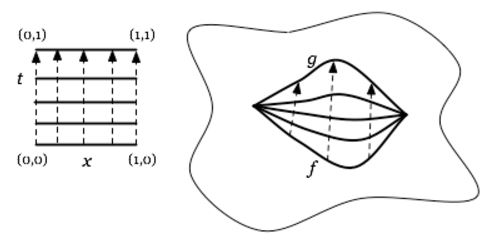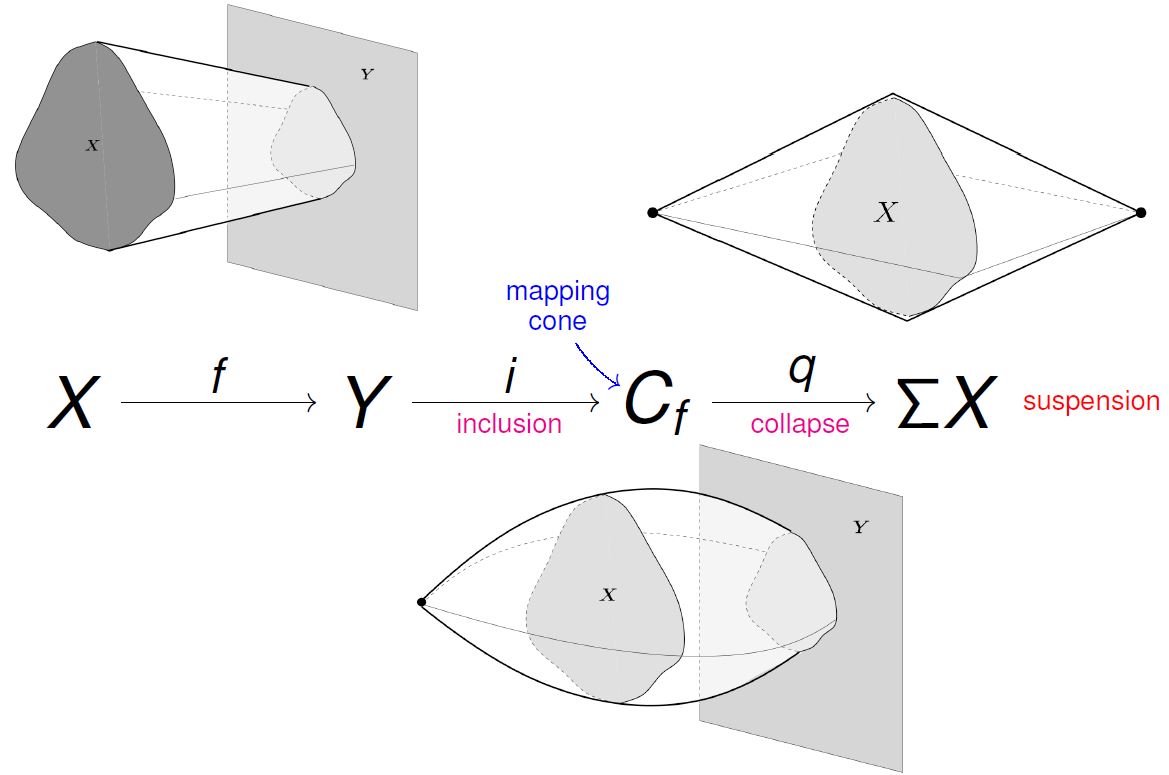nLab topological cofiber sequence
under construction
Context
Topology
topology (point-set topology, point-free topology)
see also differential topology, algebraic topology, functional analysis and topological homotopy theory
Basic concepts
-
fiber space, space attachment
Extra stuff, structure, properties
-
Kolmogorov space, Hausdorff space, regular space, normal space
-
sequentially compact, countably compact, locally compact, sigma-compact, paracompact, countably paracompact, strongly compact
Examples
Basic statements
-
closed subspaces of compact Hausdorff spaces are equivalently compact subspaces
-
open subspaces of compact Hausdorff spaces are locally compact
-
compact spaces equivalently have converging subnet of every net
-
continuous metric space valued function on compact metric space is uniformly continuous
-
paracompact Hausdorff spaces equivalently admit subordinate partitions of unity
-
injective proper maps to locally compact spaces are equivalently the closed embeddings
-
locally compact and second-countable spaces are sigma-compact
Theorems
Analysis Theorems
Homotopy theory
homotopy theory, (∞,1)-category theory, homotopy type theory
flavors: stable, equivariant, rational, p-adic, proper, geometric, cohesive, directed…
models: topological, simplicial, localic, …
see also algebraic topology
Introductions
Definitions
Paths and cylinders
Homotopy groups
Basic facts
Theorems
Contents
Idea
We discuss in detail the realization of the abstract concept of cofiber sequences in its explicit incarnation in point-set topology, the way it is traditionally presented in topology textbooks.
Hence we use the concepts of homotopy equivalence instead of weak homotopy equivalence. For discussion using the latter in the context of the classical model structure on topological spaces see instead at Introduction to Homotopy Theory the section Homotopy fiber sequences.
Background
Throughout, write for the closed interval equipped with its Euclidean metric topology.
Homotopy equivalences
Definition
For two continuous functions between topological spaces , then a homotopy
is a continuous function
out of the standard cylinder object over : the product space of with the Euclidean closed interval, such that this fits into a commuting diagram of the form

(graphics grabbed from J. Tauber here)
Definition
A continuous function is called a homotopy equivalence if there exist
Example
(contractible topological space)
A topological space is called contractible if the unique map to the point space is a homotopy equivalence (def. ).
Cofibrations
Definition
A continuous function is called a Hurewicz cofibration or just cofibration if it satisfies the homotopy extension property in that:
-
for any topological space ,
-
for all continuous functions , such that
-
and any left homotopy such that
there is a homotopy such that
-
and
If the image is a closed subset, then is called a closed Hurewicz cofibration.
Example
(retracts of relative cell complex inclusions are closed Hurewicz cofibrations)
If is a topological space and is a relative cell complex inclusion, then is a closed Hurewicz cofibration (def. ).
Also every retract of such (this sense) is a closed Hurewicz cofibration.
Pushouts / space attachments
Cofiber sequences (below) are constructed by iterated pushouts in the category Top of topological spaces with continuous functions between them (space attachments), see at Top – Universal constructions.
Example
(quotient space by a subspace)
Let be a topological space and a non-empty subset. Consider the equivalence relation on which identifies all points in with each other. The resulting quotient space is denoted .
Notice that is canonically a pointed topological space, with base point the equivalence class of .
If is the empty space, then one defines
to be the disjoint union space of with the point space. This is no longer a quotient space, but both constructions are unified by the pushout along the map , equivalently the cokernel of the inclusion:
Example
(union of two open or two closed subspaces is pushout)
Let be a topological space and let be subspaces such that
-
are both open subsets or are both closed subsets;
-
they constitute a cover:
Write and for the corresponding inclusion continuous functions.
Then the commuting square
is a pushout square in Top (see there).
By the universal property of the pushout this means in particular that for any topological space then a function of underlying sets
is a continuous function as soon as its two restrictions
are continuous.
Proof
Clearly the underlying diagram of underlying sets is a pushout in Set. Therefore (by this prop.) we need to show that the topology on is the final topology induced by the set of functions , hence that a subset is an open subset precisely if the pre-images (restrictions)
are open subsets of and , respectively.
Now by definition of the subspace topology, if is open, then the intersections and are open in these subspaces.
Conversely, assume that and are open. We need to show that then is open.
Consider now first the case that are both open open. Then by the nature of the subspace topology, that is open in means that there is an open subset such that . Since the intersection of two open subsets is open, this implies that and hence is open. Similarly . Therefore
is the union of two open subsets and therefore open.
Now consider the case that are both closed subsets.
Again by the nature of the subspace topology, that and are open means that there exist open subsets such that and . Since are closed by assumption, this means that are still closed, hence that are open.
Now observe that (by de Morgan duality)
This exhibits as the intersection of two open subsets, hence as open.
A general abstract fact about pushouts which we will use repeatedly in the proofs below is the following:
Proposition
Consider a diagram in Top (or in any other category) of the following form:
where the left square is a pushout.
Then: The total rectangle is a pushout precisely if the right square is.
We need the following two facts (prop. prop. ) regarding the stability of cofibrations under pushout.
Proposition
(pushout of cofibrations)
Let be a topological space and let be a closed Hurewicz cofibration.
Then for every continuous function , the pushout in
is also a closed Hurewicz cofibration. Moreover, if in addition
-
is a retract of a relative cell complex inclusion, then so is ,
-
is a homotopy equivalence, then so is .
Prop. is a consequence of the existence of the Strøm model structure and the classical model structure on topological spaces and of the fact that the identity functors constitute a Quillen adjunction.
Proposition
(quotient by contractible closed subspace)
Let be a closed Hurewicz cofibration.
If is a homotopy equivalence (def. ) then its pushout in
is also a homotopy equivalence.
In particular if is a contractible topological space (example ), then the coprojection
to the quotient space (example ) is a homotopy equivalence.
Prop. is again a consequence of the existence of the Strøm model structure : It is the statement that is a left proper model category which follows (this cor.) since all its objects are evidently cofibrant. An elementary proof in point-set topology is offered in (Hatcher, prop. 0.17)
Mapping cones
Definition
(topological cylinder and cone)
Let be a topological space. Then
-
the standard cylinder on is the product topological space
-
the standard cone on is the quotient space (example )
of the standard cylinder by the subspace .
Lemma
Let be a topological space. Then the canonical inclusions
are homotopy equivalences. Hence every cone is a [contractible topological space]] (example ).
Definition
(mapping cylinder and mapping cone)
Let be a continuous function between topological spaces. Then
-
the mapping cylinder of is the space attachment
of with the cylinder on , according to def. , hence the following pushout in Top
-
the mapping cone of is the space attachment
Remark
In summary, def. and def. say that for a continuous function then we have a pasting of pushout diagrams in Top of the following form:
Since is a closed Hurewicz cofibration , the pasting law together with prop. therefore implies that also is a closed Hurwicz cofibration.
Example
For a topological space, then the mapping cone (def. ) of the unique function to the point space is
This is called the suspension of .
The mapping cone of a map is to be thought of as the homotopy-quotient of the by , as opposed to be the naive quotient. This is made precise by the following two statements, lemma and lemma :
Lemma
If is a closed Hurewicz cofibration (def. ), then the coprojection
from its mapping cone (def. ) to the naive quotient space (example ) is a homotopy equivalence.
Proof
Consider the diagram
Since is a closed Hurewicz cofibration, so is , by prop. . Since is a homotopy equivalence (lemma ), so is , by prop. . But by lemma there is also a homeomorphism .
Lemma
Let be a continuous function such that the image is a closed subset.
Then there is a homeomorphism
between the quotient space (example ) of the mapping cone of (def. ) by the cone of (def. ) and the quotient space of be the image of .
Proof
Consider the following diagram in Top:
Here the top square is a pushout by example , while the bottom square is a pushout by def. . Hence the total rectangle is also a pushout, by the pasting law (prop. ). But that total rectangle is the defining pushout for (by example ). Hence the statement follows by the universal property of the pushout.
Cofiber sequences
Proposition
Let be a continuous function with closed image . Write in
for the mapping cone (spring) of the inclusion of into the mapping cone of .
Then the canonical quotient coprojection
to the suspension of (example ) is a homotopy equivalence (def. ).
Proof
Since is a closed Hurewicz cofibration (by remark ), lemma gives that
is a homotopy equivalence. But then there is the following evident homeomorphism

(graphics taken from Muro 10)
Hence from every with closed image, we get long sequences
Pointed cofiber sequence
(…)
Last revised on July 4, 2017 at 18:22:39. See the history of this page for a list of all contributions to it.